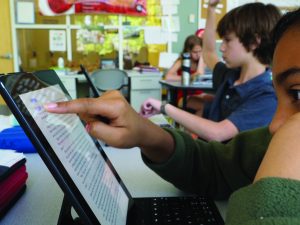It’s funny, in a way, that a word we use so often these days — “digital”— with which we associate can’t-see-‘em clouds, winged Wi-Fi access to information of any kind, and overarching on demand of everything — is based on a word that’s pretty down to-earth, direct and, well, analog: “digit,” as in a whole number less than ten or, to call up its base root, the digit called your finger. Yep, with help from the Arabs who invented “0,” the whole thing is based on our toes.
It gets even simpler for the back-brains of computers; they think pretty much in “1s” and “0s.” Most modern electronic signals, information, and data — masses beyond counting of it — is based on those two discrete values and the way they’re arranged by the click-click of a mouse, or the tap-tap of a finger on a keyboard, or the slide of it across a pad.
Sure, it’s even more complex than that. Zero and 1 spawn the web behind the web, what’s called “code” or “coding,” seemingly infinite lines upon lines of rules, symbols and typed-in text that “tell” a computer what to do and how to do it.
Teaching Colorado Academy students about coding is the backbone of the new Computer Science and Innovation course of study in the Sixth and Seventh grades of the Middle School.
“Coding,” explains Bill Wolf-Tinsman, Principal of the Middle School, “allows you to change your idea into a [computer] program that then will allow you to do the things you want to do.” To that end, the classes are aptly titled “Coding and Design.”
“Coding develops the ability to think logically and in sequence,” says Wolf-Tinsman. “Further,” he adds, “more broadly, coding develops problem-solving skills because that’s just what coding is.”
“At the basic level,” says Jared Katzman, Director of Technology at CA, “programming instructs a computer to do something. It may not be text-based; it could be drag and- drop. What’s more important [in this curriculum] are the concepts that we’re after.”
At CA, a lot of this work happens on the iPad. Students in Grades Five through Twelve enjoy a 1:1 iPad user program. (All faculty have laptops and iPads.) “This year,” says Wolf-Tinsman, “the 1:1 iPad program is in its third year. Students and faculty will continue to tap the creative, educational, and organizational power of this device.”
The ubiquity of the iPad at CA enhances the existing curriculum and supports a variety of learning styles.
Furthermore, it provides portability and — a fine side benefit — an equitable platform for all students.
“About half of CA’s technology classes,” says Katzman, “are what we call the ‘design thinking and engineering’ process: how to design a prototype of something and test it. That crosses directly with learning coding. “Our job at CA isn’t necessarily to prepare students for jobs as coders,” says Katzman. “It’s the critical thinking behind designing something and building it. If it doesn’t work, you can go back. This is all needs-based.”
Wolf-Tinsman furthers Katzman’s thought: “We want our students to be creators, to be innovators, to change their ideas into on-the-ground reality,” he says. “Part of that is to develop an innovative mindset, to be creative within the world.”

It’s no surprise, then, that the Sixth and Seventh grade classes in Computer Science and Innovation will be part of the arts rotation for students. When combined with
the Eighth Grade robotics unit, this will create a three year sequence of study preparing students well for an expanded technology and innovation curriculum in the Upper School. Other students will also have the opportunity to participate in an optional Robotics Club led by Middle School science teacher, Thanh Luong.
“The tech program in coding and design,” says Wolf-Tinsman, “gets students to translate their thoughts into code in order to have the computer do their bidding. For adults who can code, the world is their oyster; they’re in high demand because they can translate an idea through code into reality.”
“The new Sixth and Seventh Grade innovation- and design-oriented coding classes,” adds Wolf-Tinsman, “fit into the overall program that begins in the Lower School and continues into the Upper School: to have facile users and developers of technology. They might be creators of programming robots; they might create code to solve problems.
